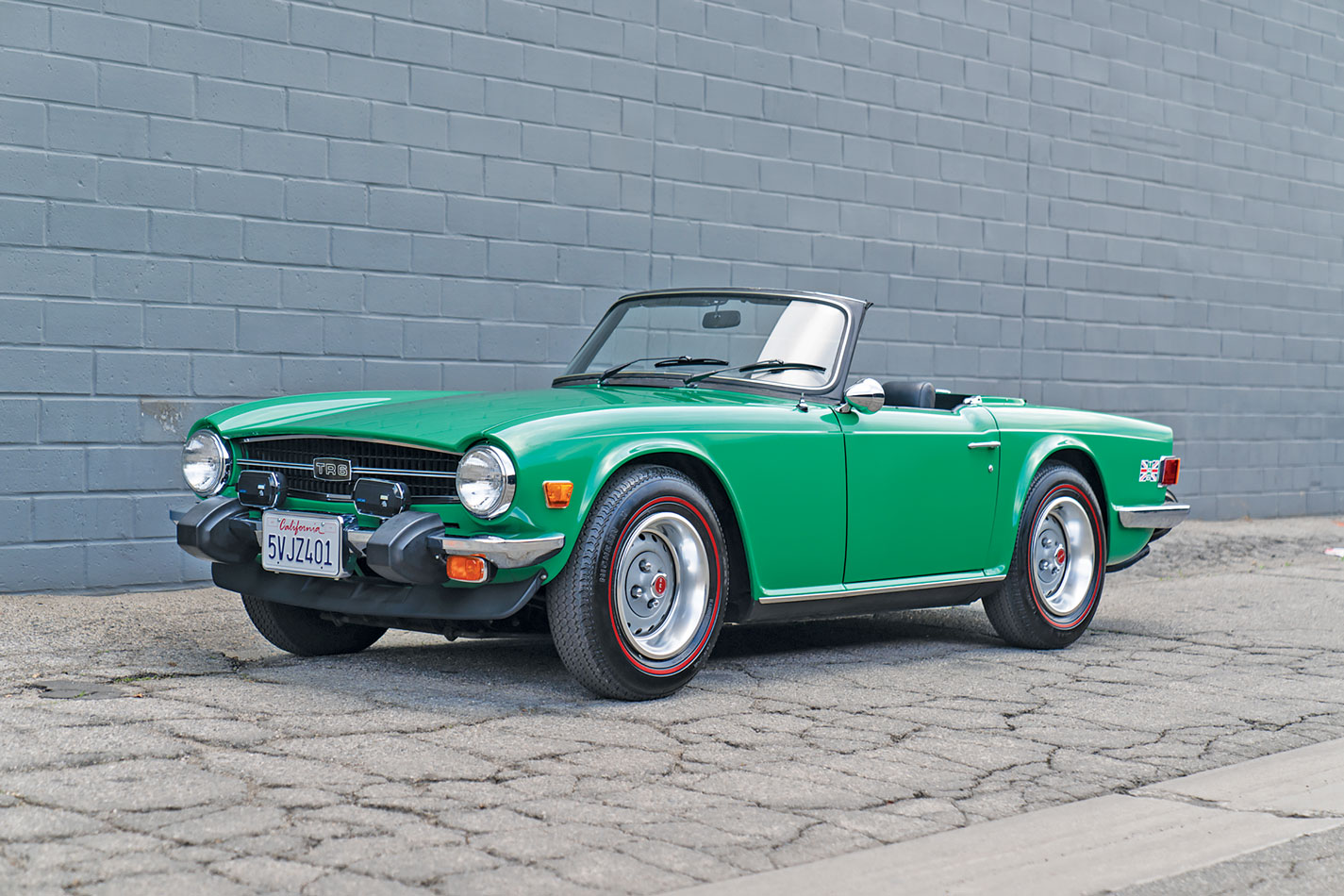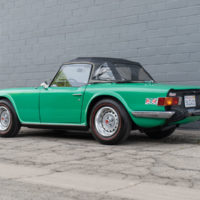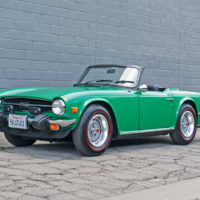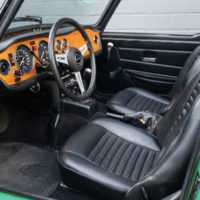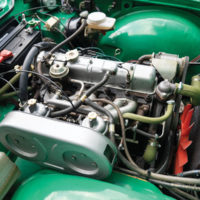The beautiful Java Green TR6 from 1976 presented here has led a particularly sheltered life, having been retained in a small collection of sports cars in Southern California from 2006 through 2021. This beautifully preserved TR6 showed just 12,150 miles at the time of cataloging, and has benefited from recent mechanical attention, which included rebuilding the twin Stromberg carburetors, cleaning the fuel tank, flushing the brake system and addressing minor electrical details. Featuring deeply dished steel wheels with Redline tires, accessory Lucas driving lights, and its optional razor-edged factory hard top, this highly original TR6 still presents much as it did when it was sold new in 1976, the model’s final year of production. “The shape of things to come,” the subsequent TR7, would bring the end of the dashing British roadster.
Among the most memorable and admired British sports cars of its era, a survivor-status TR6 is a hit at nearly any automotive gathering. This low-mileage example, one of the last thousand built, presents in its factory stock form and has a bright future ahead with its next caretaker.
SCM Analysis
Detailing
| Vehicle: | 1976 Triumph TR6 |
| Years Produced: | 1969–76 |
| Number Produced: | 94,619 |
| SCM Valuation: | $17,500 |
| Tune Up Cost: | $350 |
| Chassis Number Location: | On early cars, stamped on a metal plate affixed to the top of the inner left-hand front wing. On later cars, stamped on a metal plate attached to the left-hand “B” post, below the door-shut plate. |
| Engine Number Location: | Stamped onto a lip at the rear of the left-hand side of the block, just visible below the spark plug. |
| Club Info: | Vintage Triumph Register |
| Website: | http://www.vintagetriumphregister.org |
| Alternatives: | 1975–78 Datsun 280Z, 1970–82 Alfa Romeo Spider, 1970–76 Porsche 914 |
| Investment Grade: | B |
This car, Lot 7, sold for $44,000 including buyer’s premium, at Gooding & Company’s “Geared Online Scottsdale Edition” sale on January 28, 2022.
Looking back at the TR6 through the lens of several decades, it is easy to lump it in with a generation of little British cars that struggled to adapt and finally fell victim to a changing world, including rising fuel costs and increasingly demanding federal emissions and safety regulations. The 1970s “Malaise Era” was tough on the car hobby, but in fact, the TR6 sold strongly through some of the worst of it. Selling over 94,000 units of an old-time body-on-frame British sports car in that period suggests there was a lot still to like.
Carrying the torch
Seen by some as the spiritual successor to the last variant of Big Healey that ended production in 1967, the TR6 sold more examples than all models of Big Healeys combined. And why not? The TR6’s U.S.-spec carbureted 2.5-liter inline-6 engine may have given up almost 50 hp to its injected U.K.-market sibling, but it still sounded great, produced ample torque, and the emissions gear was easily removable — not that anyone would do such a thing.
And that brings us to one attempted antidote to Malaise Era ennui, wherein Triumph began to offer non-traditional body colors. If your favorite model’s horsepower was falling, its bumpers were growing, and its ride height reached ungainly elevations to stay abreast of government regulations, at least you could offer cool colors to excite those not afraid of garish hues. Triumph offered several, and the Java Green of our subject car is perhaps the first thing about it that draws the eye. For some it may be cringeworthy, but for others it is the perfect way to let your freak flag fly. Looking at it today, the color has aged well.
The TR6 of your dreams
Besides color, the most noteworthy attribute in this TR6’s sale price is its low mileage. With just over 12,000 miles recorded, it’s effectively a time-capsule example and consequently has suffered no irreversible loss of originality. The new owner possesses a nearly new, pampered TR6, not one of the many that have been abused, then restored and modified.
The car has also reportedly had a long-term life in a Southern California collection, suggesting that the unseen parts of the car have been nicely preserved. No rust holes will be found under the carpets to drain the blood from the new owner’s head and dollars from his maintenance budget. This TR6 also came with a handsome factory hard top and overdrive transmission. This is as close as anyone is likely to get to being able to order a TR6 today 45-plus years after production ceased.
A market outlier, well bought
As noted in our last piece on the TR6 (“Affordable Classic,” March 2019), the window of opportunity to acquire a nice one at a reasonable price has been open a while. The intervening years have done little to change that assessment. In 2019, the SCM Median Value for the TR6 was $18,000; today it is $17,500. There are still too many available for rarity to come into play, and the generation with contemporary affection for the model is not, ahem, getting more numerous.
So, what does the new owner of such an exceptional TR6 do with it? Won’t driving it decrease the value? Maybe, but the “value” of a car such as this is not found in an investment portfolio, but rather in the enjoyment derived from behind the wheel. Besides, even if 2,000 miles per year are added to the odomoter, it will still read just 32,000 in 2032 — still very low miles. By then we may see self-driving electric cars (or jet packs, or flying unicycles). While we can still buy 92 octane, I hope this Triumph’s new owner drives it.
It seems quite plausible that the TR6 is one of a number of mass-produced sports cars that will never experience a generalized price breakout. This example shows that only an exceptional TR6 sold by a major auction house in a nitrous-fueled market will achieve more than double SCM’s median price. For all of that, I still call it well bought. ♦
(Introductory description courtesy of Gooding & Company.)
